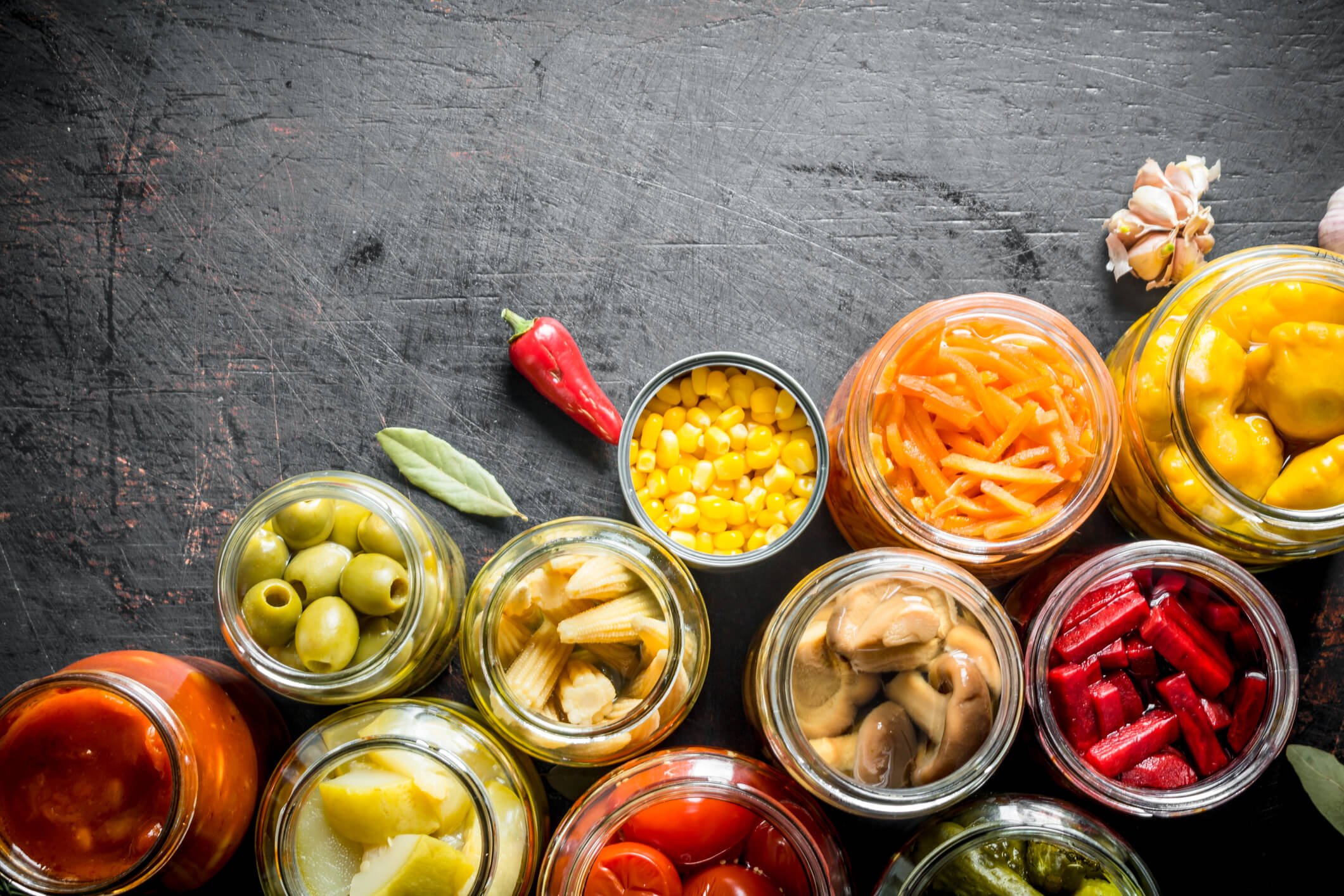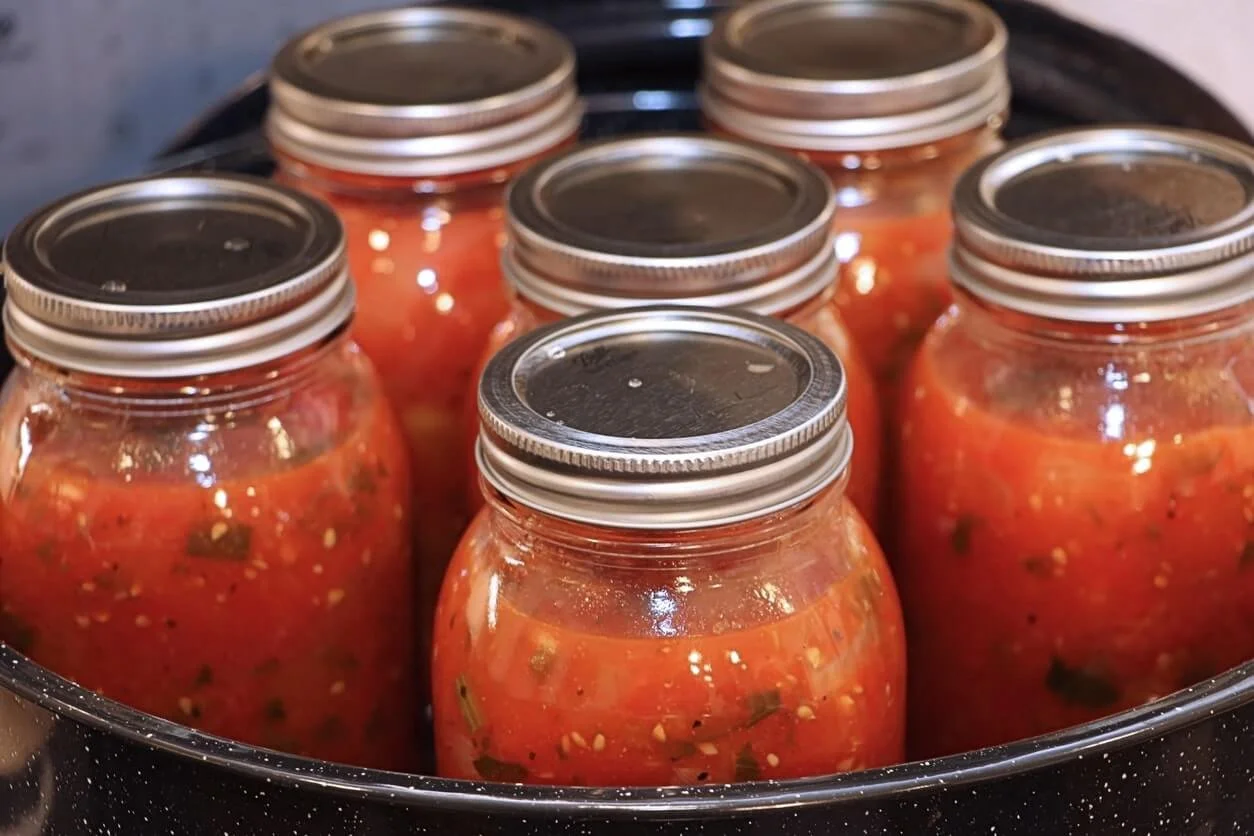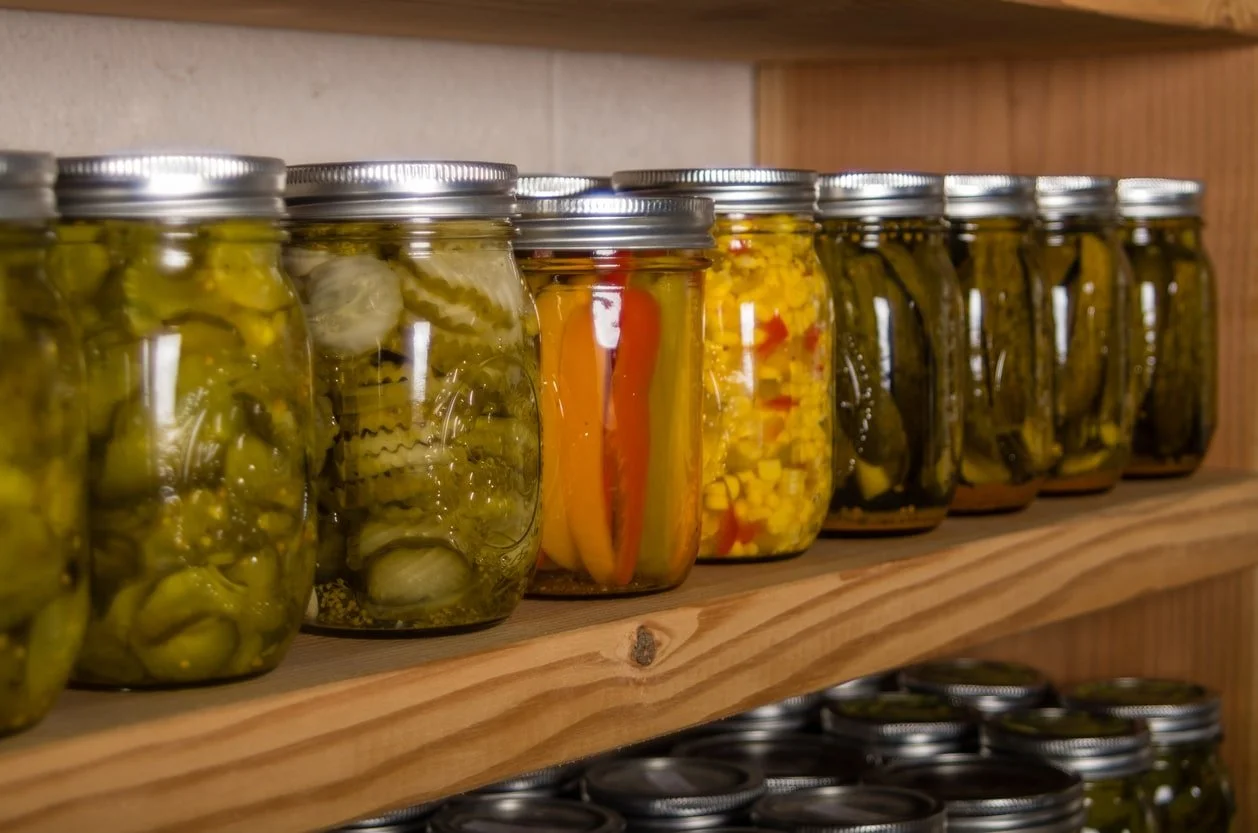Prepping For Preserves
Discover > Texas Home Cooking > Prepping For Preserves
Before refrigeration became a household staple, food preservation skills were essential. It was about surviving the winter or preserving food for long trips across a rugged country. Nowadays, it’s a skill not many people possess. However, even though it’s no longer about survival in this day and age (for the most part at least), it has huge benefits on your wallet, your environmental impact, your health, and, potentially, your community.
Produce
One of the primary historical reasons people canned and preserved, and why you should as well, was to be able to eat produce during its off-season. For example, preserving the sunny flavor of a perfectly ripe tomato at the height of summer (delicious tomato purée), and storing it for use in the depths of winter has allowed many distinct food cultures to evolve. Almost all food cultures have a relationship with preservation in their cuisine, to this day. In our modern-day life, not buying produce when it’s out of season reduces the demand, and therefore reduces the need for international shipping from places where the product can grow, or resource-heavy greenhouse cultivation.
8 Texas Fruits Perfect for Preservation
Discover the bountiful world of Texan fruits and learn how to preserve their fresh flavors with our guide to eight fruits perfect for preservation.
Eating this way also helps support your local farmer by finding most of what you need at your local market. This doesn’t just benefit you and the farmer, but your community as well, by keeping your local dollar circulating. With one quick search, you can easily find out what produce is in season, and if it grows in your area.
Freezing, Pickling, and Preserving: How to Make Fresh Food Last
Master the techniques of freezing, pickling, and preserving to make your fresh Texas produce last longer, and savor the flavors of the season year-round.
The beauty of preserving is that there are so many different methods that it’s practically impossible to ever get bored. For example, if pickled or fermented fruit doesn’t exactly appeal to you (although I highly recommend it if you’ve never tried any), you can preserve them in syrup. These are six of the most common methods of food preservation:
Drying
This involves removing all, or most, of the moisture from food. Beef jerky (how long does beef jerky last?) or dehydrated produce is a perfect example of preservation through drying. Pathogens can’t survive without water, for the most part, and you can vacuum seal them in plastic for an extra layer of protection.
Fermenting
This uses salt and water to foster the growth of particular safe microbes that preserve the food and give it a tangy, sour taste. It’s the process involved in making sauerkraut (how long does sauerkraut last?). Fermented foods (What wine goes well with fermented foods?) benefit from healthy bacteria that are super good for your gut - check out to learn more.
Pickling
Pickling, unlike fermentation, hinders any microbial growth by adding a highly acidic base to fruits and vegetables. Most microbes can’t survive in conditions under a 4.6 pH level. The ones that can are called acidophiles, so, as an extra level of precaution, all the oxygen is removed from the jar prior to storing.
Freezing
The one downside to freezing is that it requires constant, steady low temperatures to sustain. Should whatever you’re preserving thaw enough for microbes to become active again, it can be hard to know the extent of damage done and can lead to wastage. This is only a more recent method of preservation, along with the invention of the fridge.
Salting
Salting involves essentially burying produce in salt and leaving it there so that the molecules sink in making it uninhabitable for pathogens. Some examples are cured meats (What wine goes well with cured meats?) like bacon and most deli meats (how long do deli meats last?).
Jams, Jellies, & Conserves
These preserve fruits through sugar in the same way salt does, by extracting water from microbes. The pectin (how long does pectin last?) used to make these preserves also acts as a kind of cement that holds cell walls together.
Jams, Jellies & Preserves for Fall
Capture the essence of fall with our guide to creating jams, jellies, and preserves that celebrate the rich and comforting flavors of the season.
Canning
‘Canning’ can apply to pretty much any of the previously mentioned methods, so to be more specific, water bath canning, steam canning, and pressure canning are primary methods of preservation that we discuss further below. Canning works by expelling air from the jar, which, in turn, inactivates enzymes that cause food to spoil. As it cools, it also creates a vacuum seal that keeps out microbes and minimizes contact with oxygen.
Keep in mind that these methods are hardly limited to fruits and vegetables. Meats, eggs, cheese, and most other produce can be preserved in one way or another using one of these methods!
Ignite your creativity in the kitchen with our unique canning ideas, offering innovative ways to preserve and enjoy the diverse flavors of Texas.
Equipment
Cutting, Prepping, & Storing
Most of the things that you preserve will require chopping. Theoretically, you could ferment or pickle large things like whole beets or apples, but it would take much longer, therefore leaving the produce susceptible to spoilage. Cutting the produce into pieces exposes more surface area, and will most likely help you fit more into one jar. Plus, you’ve got portion-ready size when you decide to crack open that jar! While there is no replacement for a chef’s knife for any cutting task, you can buy specialized equipment like a cabbage knife for sauerkraut, or crinkle cutters to give beet slices a fancy texture.
Cutting Out Preservatives in Food
Join us on the journey of cutting out preservatives from your food, as we explore tips and tricks to embrace a healthier and preservative-free lifestyle.
There are a lot of different pieces of equipment out there that seem useless and a little frivolous, like bubble poppers, measurers, and jar lifters. It’s easy to get sucked into thinking you need to buy expensive equipment, but really all you need are a few standard household items to get you going. Canning is the same as learning any other new skill, learn to do it correctly and safely first. When you have the hang of the basics, you can start applying your own methods, experimenting, and eventually learn to make almost any preserve with just your naked eye and some basic appliances.
Jars
Jars come in such a wide variety of sizes that it’s hard to not find one that fits your needs. Today you can utilize amber jars, which have the added benefit of blocking out harmful UV light that can deteriorate your food over time. It’s not essential when you store the preserves in a dark pantry, but it’s an extra precaution you could consider.
Lids
They deserve their own section because it’s absolutely essential that a rubber seal on a jar is intact. Because rubber is so malleable, it particularly helps when you vacuum seal a jar to use good-quality rubber seals. Make sure to check it is sealed properly, so not even the smallest microbes can slip through.
Something to pressurize
There are two main ways of pressurizing a jar of produce, one is easy and straightforward and takes advantage of modern technology: a pressure canner. The downside is they can set you back anywhere from $150 up to well over $500. Alternatively, you can use a large pot and boiling water to do the same job.
Jar Lifter
A jar lifter helps a lot regardless of how often you can. Handling a hot jar is particularly dangerous should it drop and shatter. Taking extra precautions and investing in a jar lifter (they’re cheap after all!) will save you a messy clean-up job.
Vacuum Seal Bag & Sealer
Vacuum sealing bags for the freezer is necessary to prevent freezer burn on any meat or produce you stick in there. You can also vacuum seal food in zip lock backs using a tub of water like this.
Dehydrator
With a little extra hassle, you can turn your oven into a dehydrator by lining a baking tray with foil and wedging the door open with a wooden spoon, while “baking” at the lowest possible temperature your oven can go to It takes a while, but the pay-off of homemade beef jerky is irreplaceable. If you particularly like dehydrating produce, though, look into investing in a dehydrator to make the job even easier.
Ingredients
By ingredients I don’t mean produce; I mean the essentials you need to can and preserve anything. Many methods of preservation use the same key ingredients as their counterparts, which allows you to double up usage on many of these active ingredients!
Salt - There are two main types of salt you need to keep in stock if you intend to go the full mile with your preservation. Pickling salt: this is salt in a very pure form that prevents a brine from going cloudy; and curing salt: containing sodium nitrite, it’s used for things like bacon and beef jerky for that unique reddish color as well as preservation.
Sugar - Sugar is a super effective preservative especially when it’s combined with anaerobic conditions that come with pressurizing. Syrup is one of the best ways to preserve and maintain a fruit’s flavor and texture, saving the decadence of summer for the darker days waiting for spring to return.
Vinegar - Pickling is a beautiful thing because of the sheer choice of vinegar variations available. Everything from malt vinegar, to balsamic works, as long as you take all the proper considerations in mind. Balsamic vinegar (how long does balsamic vinegar last?), for example, can be overpowering and expensive so you may want to look into diluting it. If you don’t feel like being particularly experimental, you can buy gallon jugs of pickling vinegar. This is perfect for making most homemade pickles and you can even add your own spices to personalize your flavor!
Pectin - Pectin is used as a setting agent in jams and jellies, and is a must-have for someone who wants to start preserving food. Jam is, and always has been, one of the best methods of preserving fruit while also maintaining its sweetness and taste. Keep in mind that fruits aren’t the only thing that can be jellied. Things like hot peppers, tomatoes, onions, and carrots can be used, too.
Canning Meat: A Comprehensive Guide for Preservation
Dive into the art of meat preservation with our comprehensive guide to canning, ensuring your favorite meats are stored to perfection.
Storage
There are a couple of things to consider when storing preserves in the long run. Taking consideration of these points will ensure that your jars will last for months, even years, ahead.
Embark on a pickling journey from start to finish, learning the fundamentals of preserving fresh vegetables for a crisp and flavorful outcome.
Temperature
Warmth will leave your preserves susceptible to spoilage. It may not seem important,, but it’s not a risk you want to take with a big batch of pickles that you’ve spent energy and time making. Even with high salt, acidity, or sugar, there are microbes that can thrive in those conditions. And with the extra layer of precaution that vacuum sealing creates there are some that prefer anaerobic conditions. Preserving is all about adding layer upon layer of protection from spoilage and keeping the temperature right is just another way of doing so.
Light
Light may not have a profound effect on preserves in the short term, but can over several months. If you place your jars in a pantry that you open and close multiple times a day, buying some amber jars, which exclude harmful UV rays, is worth looking into. If you have a basement or a shed, this could be an ideal place to store your jars, as long as they are temperature-friendly and won’t cause any of the jars to freeze.
The Fall is the perfect time to start preserving, and starting with just one method is a good way to get started! Look for your local farmers market for seasonal produce you can preserve this month or go to your local butcher and get a hold of some grass-fed beef. Or if you know an avid hunter ask him if he has any venison (What wine goes well with venison?) you can take off his or her hands.
Jellies, Jams, Compotes, and Preserves: What's the Difference
Uncover the nuances of jellies, jams, compotes, and preserves as we explore the differences between these delightful forms of preserved fruits.
Next week, part 2 of this series will tell you about the seasonal veggies you can pickle, ferment, and can before the cold months set in.





